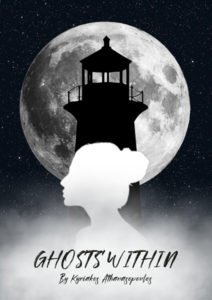See here for my IFComp 2021 scoring and reviewing rubrics.
Ghosts Within is a game of mystery and suspense set in and around the quiet fishing village of Foghelm. The game’s ABOUT command reveals author Kyriakos Athanasopoulos wrote it
as part of his Diploma thesis on Interactive Fiction, for the Department of Electrical and Computer Engineering at the University of Patras, Greece! It is the first-ever attempt of the author to create such a game.
Ghosts Within opens with a combination of familiar tropes. You awake in a dark forest with your memory fuzzy how exactly you got there. Wandering around, you meet a number of mysterious characters who give dodgy answers about their backgrounds and their relationships with the others.
The author went heavy on atmosphere and location for Ghosts Within. Fog comes and goes. Locales are bathed in moonlight. A young woman tends to her flowers in the middle of the night. You visit a rustic graveyard and a seemingly abandoned lighthouse. A hotel manager seems friendly enough, but she keeps glancing behind you as though someone just passed by, although no one else is in the lobby.
The smell of damp moss fills the air. Wet grass and dirt surround you while you are lying face down on the cold forest floor. Your clothes are dirty, wet, and slightly torn in places. Your head’s left side is throbbing, your heart is pounding irregularly, and your limbs have gone numb from the pain. You try to examine your surroundings, but the lighting is dim from your current position to do that. You try to stand up, but it feels way too exhausting. You try a second time with the help of a nearby fallen branch; finally, you manage to raise yourself from the ground…
Also in the ABOUT, the author admits there are not many puzzles, and I would second that. Ghosts Within is a game of exploration and conversation, with details gradually accumulating to reveal histories and submerged connections. It’s a rather large game for a first-time author. Most of my play time was spent wandering about and talking with the residents of Foghelm.
In fact, I came to realize the game’s map-heavy layout was complemented by the count of NPCs one can converse with. Speaking with one NPC will unlock new topics with NPCs you’ve already met. I appreciated that you may lie to some of the residents of Foghelm—and that telling the truth is not always in your best interests. There are three starting points and multiple endings; the author expects players to play several times through to truly finish the game. The different starting points create Roshomon-like effects when encountering the same NPCs in different play-throughs. (For example, from one starting point, I wondered why I met a certain character at a phone booth in the middle of the night. After a second starting point, I at least had a clue why she would be there.)
For all the game’s promise, there are disappointing, but forgivable, issues. Some of the grammar and dialogue is a bit wooden, and there are a number of minor typos. On the flip side, this game did teach me that “clowder” is a collective term for cats, and casually drops the word “seiner” in a description, which I’m convinced I’ve never seen before in print. And as the above quote suggests, these are not pervasive problems.
Another issue deals with movement around the map. Many of the outdoor descriptions are little more than enumerating exits and directions. Some are confusing, with directions and details becoming a blur of compass points. This is one of the problems with a map-heavy game, especially in one so conscious of atmosphere and setting.
The most jarring bug is related to NPC interactions. For example, a nearby research facility can be a topic of discussion with another character, but I had no reason to know about it before that moment.
All said, I’m thoroughly impressed with Ghosts Within. Hats off to a first-time implementor writing a game that leans heavy on NPCs, conversations, and knowledge. Ghosts Within offers spookiness, tons of ambiance, and a gradual accretion of details that lead toward solving at least three mysteries: Who you are, why you’re there, and what really happened long ago in the village of Foghelm.
Addendum: The author posted an updated version after my first run through the game. It’s possible the issues I mentioned have been fixed, as I did not have the chance to try to reproduce them later.
Also, the author informed later that English is his second language. While I stand by my criticism on the points about dialogue and grammar, it certainly makes his effort that much more of an achievement.
